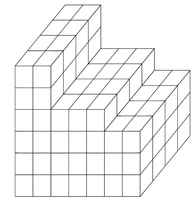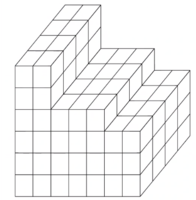jhonmcgiver
New member
- Joined
- Nov 10, 2020
- Messages
- 6
I know the process, I just can't see to put all the pieces togetherHow many squares on the left side that you can't see?
How many at the back that you can't see?
How many underneath that you can't see?
All the others you can see, and at the very least, you can count.
Give it a go! Then we can check your answer if you like.
Think about it! How do you calculate the total surface area of a cube?I know the process, I just can't see to put all the pieces together
I know the volume is 120.
I know the individual area of each figure is
A1 = 8(2) = 16
A2 = 12(2)= 24
A3 = 6(2) = 12
B1 = 12(2) = 24
B2 = 16(2) = 32
B3 = 12)2) = 24
C1 = 12(2) = 24
C2 = 24(2) = 48
C3 = 12(2) = 24
I just don't know what to do next. Do I add all the numbers together? Do I need to substract the overlapping cubes? I have seen many videos and read many tutorials but all seem to side very simple shapes or formulas that don't work for this specific example.
If it was an easy as counting the cubes I can't see, I would not have posted a thread here.

I counted 30 on the front, and because I know the back must be the same number, I just added another 30.Incorrect.
You say:
30 on the front, 30 on the back
How did you get that?
I agree with that calculation. Assuming that the figure is solid.30 on the front, 30 on the back
12 on the right, 24 on the left
28 on the bottom, 40 on the top.
Adding it all up, it should be164.
Is this the right surface area?
I agree with that calculation. Assuming that the figure is solid.
 The bottom (invisible) rectangular face has 7* 4 cubes → surface area = 28
The bottom (invisible) rectangular face has 7* 4 cubes → surface area = 28View attachment 23036 The bottom (invisible) rectangular face has 7* 4 cubes → surface area = 28
Back rectangular face (invisible) has 6 * 4 cubes → surface area = 24
Stepped area → 4 * 3 + 4*2+ 4 * 1 + 4*3 + 4 * 2 + 4*2 → surface area = 52
Front and back L shaped area → 2*(7 * 3 +5*1 + 2*2) = 60
Total surface area = 28 + 24 + 52 + 60 = 164
That is the complete work - and you should explain your work step-by-step.
I agree with that calculation. Assuming that the figure is solid.
